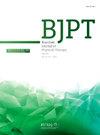Cervical flexion posture during smartphone use was not a risk factor for neck pain, but low sleep quality and insufficient levels of physical activity were. A longitudinal investigation
IF 3.2
3区 医学
Q1 ORTHOPEDICS
引用次数: 0
Abstract
Background
There is a lack of longitudinal studies investigating the association between cervical flexion posture during smartphone use (commonly referred to as text neck [TN]) and neck pain (NP).
Objective
To investigate whether TN is a risk factor for NP, considering the influence of lifestyle and psychosocial factors.
Methods
A 12-month longitudinal study. The sample consisted of 457 volunteers of both sexes, aged between 18 and 65 years, without NP. Sociodemographic, anthropometric, lifestyle, psychosocial, and smartphone-use data were collected through a self-reported questionnaire. TN was assessed objectively at baseline by measuring the cervical flexion angle using the cervical range of motion device (CROM) with participants standing and sitting while texting on their smartphones. One year after the initial assessment, participants were assessed regarding the point prevalence and frequency of NP.
Results
Of the total, 396 (87 %) participants completed the one-year follow-up. NP was reported by 40 (10 %) participants. Multiple logistic regression analysis showed that TN did not increase the chance of NP (standing OR [95 % confidence interval] = 1.0 [0.97, 1.04]; sitting OR = 1.01 [0.98, 1.04]) or frequency of NP (standing OR = 1.01 [0.99, 1.03]; sitting OR = 1.00 [0.99, 1.02]) after baseline. However, low sleep quality (OR = 1.76 [1.17, 2.63]) and insufficient level of physical activity (OR = 2.41 [1.03, 5.65]) increased the chance of NP.
Conclusion
Cervical flexion posture during smartphone use was not a risk factor for NP or frequency of NP, but low sleep quality and insufficient levels of physical activity were.
使用智能手机时的颈椎屈曲姿势并不是导致颈部疼痛的危险因素,但睡眠质量低和身体活动水平不足才是。纵向调查
关于使用智能手机时颈椎屈曲姿势(通常被称为“短信脖”[TN])与颈部疼痛(NP)之间的关系,目前缺乏纵向研究。目的考虑生活方式和社会心理因素的影响,探讨TN是否为NP的危险因素。方法采用为期12个月的纵向研究。样本由457名男女志愿者组成,年龄在18到65岁之间,没有NP。社会人口学、人体测量学、生活方式、心理社会和智能手机使用数据通过自我报告问卷收集。通过使用颈椎活动度测量仪(CROM)测量颈椎屈曲角度,在基线上客观评估TN,参与者站着和坐着,同时用智能手机发短信。初步评估一年后,参与者被评估关于NP的点患病率和频率。结果396名(87%)参与者完成了为期一年的随访。40名(10%)参与者报告NP。多元logistic回归分析显示,在基线后,TN并未增加NP发生的几率(站立OR[95%置信区间]= 1.0[0.97,1.04];坐着OR = 1.01[0.98, 1.04])或NP发生的频率(站立OR = 1.01[0.99, 1.03];坐着OR = 1.00[0.99, 1.02])。然而,睡眠质量低(OR = 1.76[1.17, 2.63])和身体活动水平不足(OR = 2.41[1.03, 5.65])会增加NP的发生几率。结论使用智能手机时的颈椎屈曲姿势不是NP或NP发生频率的危险因素,但睡眠质量差和体力活动水平不足是NP发生的危险因素。
本文章由计算机程序翻译,如有差异,请以英文原文为准。
求助全文
约1分钟内获得全文
求助全文
来源期刊
CiteScore
6.10
自引率
8.80%
发文量
53
审稿时长
74 days
期刊介绍:
The Brazilian Journal of Physical Therapy (BJPT) is the official publication of the Brazilian Society of Physical Therapy Research and Graduate Studies (ABRAPG-Ft). It publishes original research articles on topics related to the areas of physical therapy and rehabilitation sciences, including clinical, basic or applied studies on the assessment, prevention, and treatment of movement disorders.

 求助内容:
求助内容: 应助结果提醒方式:
应助结果提醒方式:


